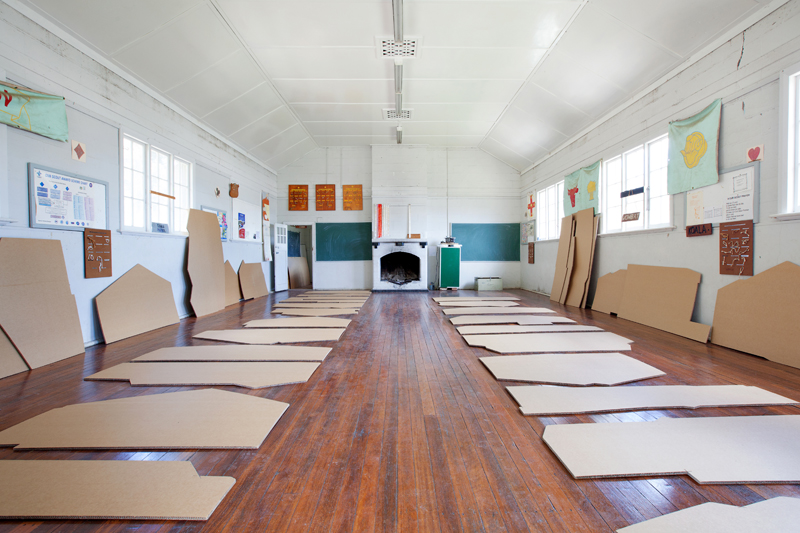 |
|
||||||||||||
Margaret Roberts Polygon Landscape 2013 (triwall cardboard and Kandos) in Cementa13, contemporary art festival in Kandos, NSW February 1- 4, 2013. ( Sentinal 01 by Daniel Stocks is also just visible on the green box beside the fireplace). Thanks to Margaret Seymour. Photo: Jo Rankine |
|||||||||||||
To make Polygon Landscape, forty polygons were cut from 2m x 1m sheets of triwall cardboard and laid out on the floor of the Kandos Scout Hall for identification by local residents, or by anyone with a visual memory of the town. Each polygon is the shape of the street-view of a randomly selected Kandos house, with details such as chimneys and eaves removed for ease of cutting by circular saw. This also had the effect of increasing the ambiguity of each shape, something that is also encouraged the blankness of the unmarked triwall cardboard. The ambiguity means that people might see each polygon's likeness to the house in which it originated, but might also see the connectedness between things or even the broader challenges of identification, etc. The reduced specificity also reflects the general dissolution of forms that occurs with time - the 'entropy' Robert Smithson writes about, the missing noses and arms on statues of antiquity, the generalisation of forms burned by fires and damaged in floods, and so on. The ambiguity of the shapes also reflects the joint individual and collective ownership of and responsibility for places, something that may be more evident in towns than in cities and which can extend from individual houses in which people live to the entire planet where we all live. It also enables the work to be located in the memories of Kandos people and anyone who knows that particular place, as that is where the abstraction of the polygons can be converted back into the specific place and history in which they originated. Without that local knowledge, the shapes remain generalised house/coffin/figure-like shapes. The polygons were laid out in rows in the Scout Hall to simulate the process of identifying bodies after disasters, thinking of how we only begin to realise how much we value things after they are lost (or about to be), and thinking of how much this applies to what is currently being lost through the abuse of the environmen in recent centuries. In inviting residents to try to recognise a shape and take it home and care for it, the work is also inviting people to recognise the value of this broader home. It is a ritual act of caring for a home that might magically catch on and extend to the whole planet if enough people do it. POLYGONS in the windows at KANDOS PROJECTS in 2022 Also in Cement Town: Placing Cementa 13 at Crossart 2013
|
|
||||||||||||